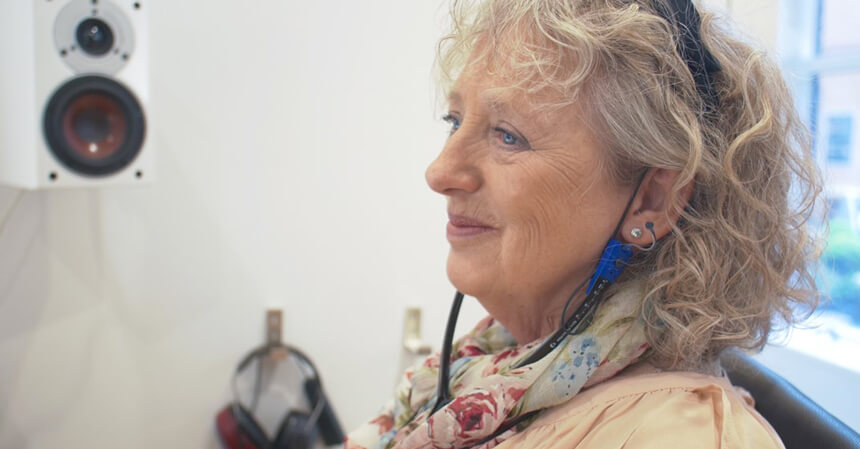Live Speech Mapping and Real Ear Measurements, Why You Need Them During Your Hearing Aid Journey
In a conversation with Steve recently it became obvious that we hadn't taken a real stand on a subject that is important to us. Looking back at it, I don't really know why we haven't done it before now. The subject is probe tube measurements of hearing aids. They are more commonly called Real Ear Measurements (REMs) and Live Speech Mapping. They are elements of hearing aid verification and validation. They are the best practice, the gold standard in hearing aid fitting. They are a proven strategy for increasing satisfaction with hearing aids and have been for many years. In fact, as a consumer advice site, advising you of what they are, what benefit you will derive from them and why you should demand them is really our job. Well, we may have failed you up to now, but we are fixing it today. Let's talk about what they are, how they are done and why you aren't getting the best service if a hearing care professional doesn't carry them out for you.

In the image above, much thanks to Auditdata (a manufacturer of real-ear measurement equipment and audiometers) for the use of it, you can see a lady sitting with a Probe Tube measurement system on her ears. You can just make out the white tube inserted into her ear canal which is used to measure the sound close to the eardrum. Before I go into how, let's talk about why.
What do REMs and Live Speech Mapping Offer?
They are forms of verification of a prescriptive target and validation of a prescriptive target. Let me explain the difference. Real Ear Measurements are designed to verify that the hearing aids in your ears are actually hitting the targets prescribed by the fitting prescriptions Nal and DSL. Those fitting prescriptions have been with us for many years and in the clinical world, they are accepted as the very best fitting prescriptions.
However, not everyone agrees that in the modern world of hearing aids, that Nal or DSL is still the best way forward. Some people, like me, think that hearing aid manufacturers often use their own fitting prescriptions because they know their hearing aids best. With that in mind, we need a test to see if those non-standard (as such) prescriptions deliver the speech signal needed to help people.
We can't use REMs to verify because all REM protocols are designed just for Nal and DSL, however, we can validate it using live speech mapping to ensure that a controlled speech signal is amplified into the residual hearing envelope of a Patient. For me, and it is only a personal opinion, live speech mapping is the better option. That is mainly because I am not necessarily beholden to Nal or DSL.
Why are REMs and Live Speech Mapping Important?
These tests are important because they verify or validate that the hearing aid is actually providing the sound that you need to hear better. The settings take your hearing loss into account and provide the calculations for the amplification needed to deliver for you. Then when we run the tests they actually assess what is going on in your ear canal. There is no guessing, no trusting the hearing aids to just work, it is a clear assessment of whether they are delivering or not.
This allows us to make real-time changes to the hearing aid settings to ensure that they do deliver exactly what you need. More than that, all of the studies undertaken into the use of verification and validation within hearing aid fittings show that people get on better and are more satisfied with their hearing aids when it is done.
The Possible Pitfalls
Here is the thing though, when we use these tests we get the hearing aids to the optimal settings for your hearing loss. You actually might not like the sound, in fact, you might hate it and need it turned down. That's okay, that's fine, I will explain to you that you won't get the best possible experience but we can help you work towards it during your rehabilitation. Just because you might not like the sound, doesn't mean I shouldn't do it, and anyone who uses that excuse is talking rubbish. Utter and contemptuous rubbish.
How is it Done?
Both test procedures are done in a similar way, we use a probe tube system, most are exactly like the one in the picture above. There is a probe for each ear. First, we calibrate the probe tubes by holding them in front of a speaker which plays the calibration tones. This doesn't have to be done every time, just after the probe tubes have been changed. Normally, we would only use the probe tubes for one person, then throw them away.
After the calibration, we would hang the system from your ears and place the probe tubes in your ear canals. We are trying to get them within 5mm of your eardrum. To do so, we would normally check the positioning visually. Once that is done, we play different test signals through the speaker to assess what is happening. This can be done with no hearing aids in, with the hearing aids in and turned off and finally with the hearing aids in and turned on.
The results are shown on our computer visibly and we can see clearly where the amplification is missing the targets if that is the case. Sometimes, the amplification might not be enough, sometimes and in certain ears, we see that there may be too much amplification at one or more points. You know what, sometimes it is bang on target. In fact, more often than not in the last few years, it is more or less bang on target.
Here's the thing though, we don't and can't know that for sure. So the fact that many modern hearing aids perform in the ear as they should. Is not an excuse not to undertake the test. Again, anyone who says it is is speaking utter rubbish. I have heard many excuses for not performing probe tube measurements on hearing aid users. They are generally all utter and contemptuous rubbish. Dr Cliff Olson AuD has a couple of great videos on the subject on Youtube. In one, he identifies and refutes each excuse. Let's take a look at those excuses and his answers:
- Bad Excuse #1. New hearing aids are so advanced that they can self-calibrate to your hearing loss. If you truly believe that a hearing aid self-calibration could perfectly fit your hearing loss, then why would you need a hearing care provider at all? The truth is, even hearing aid manufacturers themselves advise providers to perform Real Ear Measurement. They request this because they know more hearing aids are returned for refunds when these measurements are not performed.
- Bad Excuse #2. Real Ear Measurement is only for complex cases of hearing loss. Yes, some hearing losses are more complex than others. However, all hearing losses have a prescription that must be met. Does a surgeon only wash his/her hands before "complex" surgeries? No, they wash their hands for all surgeries because best practices indicate that they should. Complex or not, the only way to ensure that your hearing loss prescription is being met is to perform Real Ear Measurement.
- Bad Excuse #3. Real Ear Measurement can't be used in cases of Single Sided Deafness (SSD). When you have SSD, some of your treatment options included CROS and BiCROS. This is when sound is taken from your deaf side and sent to your better hearing ear. This helps to overcome headshadow effects. It is comical to think that you wouldn't need to verify if the headshadow effect has been compensated for and if a prescription for hearing loss in the better ear has been met.
- Bad Excuse #4. Real Ear Measurements don't provide any additional benefit over not using them. Yes, in some cases default programming of hearing aids will provide some hearing benefit. However, research study after research study indicate that performing Real Ear Measurement provides consistently better outcomes than not performing them. In a study be Levitt and Flexor (2012), the performance of seven hearing aids were compared with using REMs and without using REMs in a background noise. In every device, the performance in background noise was better when Real Ear Measurement was used. Even the Old Analog hearing aid programmed using REMs outperformed all of the Premium Digital hearing aids that did not have these measurements performed on them.
- Bad excuse #5. Real Ear Measurements are not repeatable. This is probably the worst excuse of them all. The claim is that from measurement to measurement, you will get different results. However, any Real Ear equipment that has been properly calibrated is designed to function within a specific +/- range of repeatability. They even have reference microphones to ensure that the sound coming out of the loudspeaker is at the correct level throughout the measurement. Just to be clear, there is no test in the history of the world that doesn't have at least some variability. The question is, does it fall within the pre-determined realm of acceptability? With Real Ear Measurement, the answer is YES!
DR Cliff Olson AuD: 5 WORST Excuses to NOT use Real Ear Measurement
When Should it be Done?
The answer to that is when you are to full prescriptive level, that could be at the first fitting or it may be later, let me explain. If you are new to hearing aids, most professionals will not fit you to your prescription level at the beginning. You simply wouldn't be able for it. You would find it uncomfortable and loud. To manage that, we tend to fit you to a reduced level and over a varying (varying because it depends on the Patient) amount of time we would move you to the prescriptive level.
It is then that the process should happen because it is then that we have reached the best possible amplification for your hearing loss. Therefore, that is the time to test the outputs in the ear. If you are an existing user of hearing aids buying a new set of hearing aids, well then we might fit you to prescription immediately. If so, well then the process should be done at the fitting.
The Best Possible Outcome
If I am committed to delivering the very best possible outcomes for my customers, I need to undertake some sort of probe tube measurement be it REMs or Live Speech Mapping. It is only then that I can be confident that I am delivering what is needed to deliver the parameters for the best possible outcome. Having said that, in some cases, even after delivering those parameters there can still be problems.
Hearing and hearing ability is unique. Sometimes people with treatable hearing losses have problems understanding speech in noise no matter what is done with their hearing aids. This is a function of an underlying problem in the hearing area of the brain and no matter how well the hearing aids are fitted, they may struggle to help. Here's the thing though, we, and by that I mean the professional and you the user, will never know that is the case unless we have clear and irrefutable evidence that the hearing aid is performing at it's best. Irrefutable evidence that it is doing exactly what it should in the ear canal of the user. The only way to gain that irrefutable evidence is through probe tube measurements.
I echo Cliff Olson when he says "I find it sad that some hearing care providers feel the need to fabricate excuses as to why they don't feel the need to perform Real Ear Measurement." We have known for years that all the studies support it as a best practice. In fact, Best Practice guidelines indicate that probe tube measurements are the Gold standard for hearing aid verification and validation.
Find A Provider Who Does
It is our best advice to you, knowing what we know, after studying the studies available, and indeed through my own experience fitting hearing aids, that you need probe tube measurements as part of your hearing aid journey. It is our best advice to you, to find a hearing care provider who does offer them when you are purchasing hearing aids. Ask any provider you deal with, do they offer probe tube measurements, if they say no, tell them you will go somewhere else.
In a later article, I want to cover the study evidence that is available in relation to this subject. Don't worry, I won't bore you with blah, but I will arm you with the relevant information. Like us on Facebook or sign up to our newsletter to keep up with our latest navel-gazing. Dr Cliff Olson AuD has done a couple of videos on Real Ear Measurements, simply search Youtube with the term real ear measurements to find them all.










